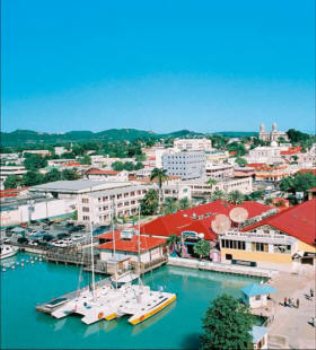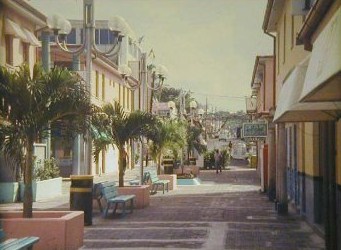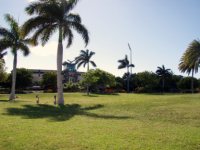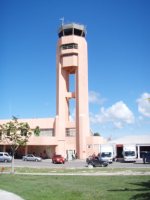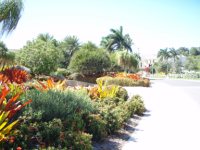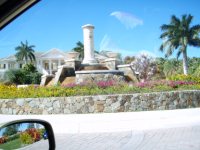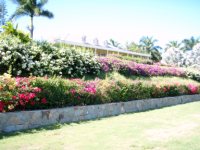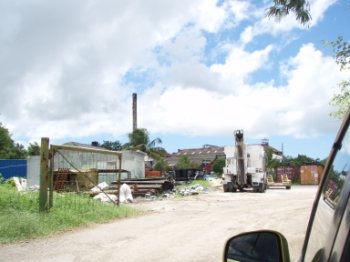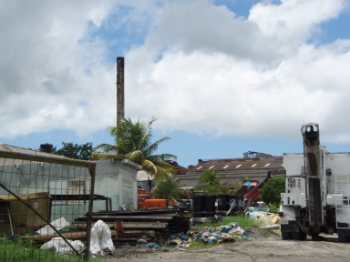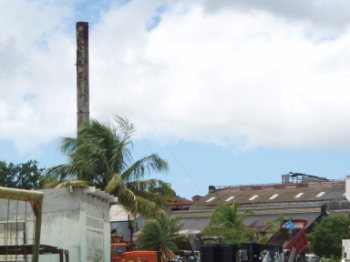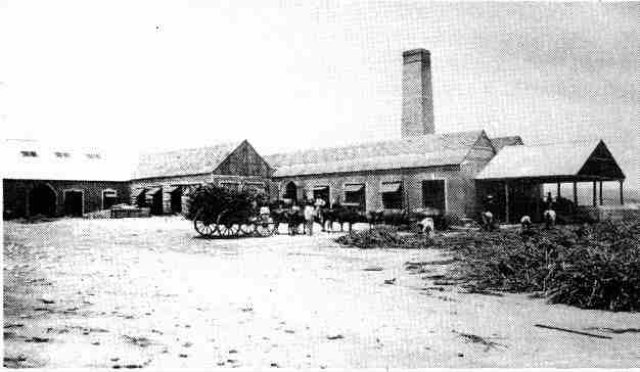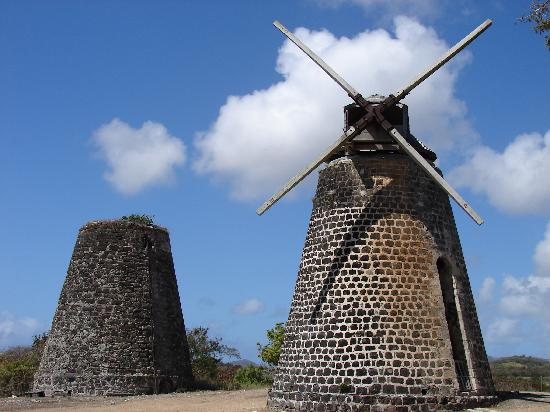Antigua

|
Antigua
- land of sea and sun as it says on car number plates.
Antigua (pronounced An-TEE-gah ) Antigua
means "ancient" in Spanish and was named by Christopher Columbus after a church
in Spain, Santa Maria La Antigua - St. Mary the Ancient. The country was
originally called Wadadli, from the original Amerindian inhabitants, and means
approximately "our own". The island's circumference is roughly 54 miles - area 108 square miles. Its population is about 69,000 as of July 2006. It is the largest of the Leeward Islands, most developed and prosperous due to its upscale tourism industry, offshore banking, internet gambling services, education services, including two medical schools. Terrain: mostly low-lying limestone and coral islands, with some higher volcanic areas. Time: GMT +4 hours, BST +5.
Over 31,000 people live in the town of
St. John's, the
capital which is situated in the northwest and has a deep harbour which is able
to accommodate large cruise ships. Days that they are in brings bustle to the
city. Other leading population settlements are All Saints (3,412) and Liberta (2,239), according to the 2001 census.
English
Harbour on the
south-eastern coast is famed for its protected shelter during violent storms. It
is the site of a restored British colonial naval station called "Nelson's
Dockyard" after Captain Horatio
Nelson. Today English
Harbour and the neighbouring village of Falmouth are internationally famous as a
yachting,
sailing destination and provisioning centre. During Antigua
Sailing Week, at the
end of April and beginning of May, the annual world-class regatta brings many
sailing vessels and sailors to the island. The high rocky coast is indented by
many bays and arms of the sea, several of which form excellent harbours. The
surface is comparatively flat, and there is no central range of mountains as in
most other Caribbean islands, but among the hills in the
southwest is Boggy Peak at 1,319 feet (402 m). Owing to the absence of rivers,
the paucity of springs, and the almost complete deforestation, Antigua is subject to frequent
droughts, and although the average rainfall is 1,158 mm or 45.6 inches, the
variations from year to year are great. The problem is partly solved by
desalination plants. Economy: Antigua's economy is heavily reliant upon tourism, and it markets itself as a luxury Caribbean escape. Many hotels and resorts are located around the coastline.
V. C. Bird International Airport is the island's single airport is serviced by several major airlines. The Bank of Antigua, the Sticky Wicket with its Stanford Cricket Ground and several prestigious businesses have their base here and as you turn into the airport you are met by beautifully manicured flower beds. History Antigua history, rich in intrigue, is
well-known among maritime buffs and English scholars. Prior to European
exploration, however, the first residents in Antigua history were the Ciboney
Indians, who inhabited the island for several thousand years before mysteriously
departing. Pastoral Arawak Indians settled here before being replaced by the
war-like Caribs, the last group in Antigua history to inhabit the island before
it was 'discovered' by Europeans. That occurred in 1493, when Christopher
Columbus spotted Antigua on his second voyage. Antigua history did not change
dramatically for nearly 150 years after as the Caribs resisted any European
efforts to colonise. The Arawaks were the first well-documented group
of Antiguans. This group paddled to the island by canoe (piragua) from Venezuela, ejected by the Caribs - another people indigenous to the
area. Arawaks introduced agriculture to Antigua and Barbuda, raising, among
other crops, the famous Antiguan "Black" pineapple. They also cultivated various
other foods including: Corn, Sweet
potatoes, Chilli’s, Guava, Tobacco,
Cotton and Mango. The bulk of the Arawaks left Antigua
about A.D. 1100. Those who remained were subsequently raided by the Caribs.
According to The Catholic Encyclopaedia, the Caribs' superior weapons and
seafaring prowess allowed them to defeat most Arawak nations in the West Indies.
They enslaved some and cannibalized others. The Catholic Encyclopaedia does note
that the European invaders had difficulty identifying and differentiating
between the various native peoples they encountered. As a result, the number and
types of ethnic/tribal/national groups at the time may have been more varied and
numerous than the two mentioned in this blog. Finally, in 1632, Sir Christopher
Codrington, an Englishman, established the first permanent European settlement.
From that point on, Antiguan history took a dramatic turn. Codrington guided
development on the island as a profitable sugar colony. For a large portion of
Antiguan history, the island was considered Britain's "Gateway to the
Caribbean". It was located on the major sailing routes among the region's
resource-rich colonies. Lord Horatio Nelson, a major figure in Antiguan history,
arrived in the late 18th century to preserve the island's commercial shipping
prowess. According to A Brief History of the
Caribbean, European and African diseases, malnutrition and slavery eventually
destroyed the vast majority of the Caribbean's native population. No researcher
has conclusively proven any of these causes as the real reason for the
destruction of West Indian natives. In fact, some historians believe that the
psychological stress of slavery may also have played a part in the massive
number of native deaths while in servitude. Others believe that the reportedly
abundant, but starchy, low-protein diet may have contributed to severe
malnutrition of the "Indians" who were used to a diet fortified with protein
from sea-life. The indigenous West Indians made
excellent sea vessels which they used to sail the Atlantic and Caribbean. As a
result, Caribs and Arawaks populated much of South American and the Caribbean
Islands. Relatives of the Antiguan Arawaks and Caribs still live in various
countries in South America, notably Brazil, Venezuela and Colombia. The smaller
remaining native populations in the West Indies maintain a pride in their
heritage. Europeans: In 1632, a group of English colonists left St. Kitts to settle in Antigua. Under Edward Warner, their leader, they grew cash crops of tobacco, ginger, and indigo.
The ruins of the old sugar factory Slavery: Sugar became Antigua's main crop from
about 1674, when Christopher Codrington settled at Betty's
Hope Estate. He came
from Barbados, bringing the latest sugar technology
with him. Betty's Hope, Antigua's first full-scale sugar plantation, was so
successful that other planters turned from tobacco to sugar. This resulted in
their importing tens of thousands of slaves, as sugar cultivation and processing
was labour intensive. According to A Brief History of the
Caribbean, many West Indian colonists initially tried to use Indians and whites
as slaves. Unfortunately, these groups succumbed easily to disease and/or
malnutrition, and died by the thousands. The African slaves had the misfortune
of adapting well to the new environment; and thus became the number one choice
of "unpaid labour." In fact, the slaves thrived physically and also provided
medical services, and skilled labour, such as carpentry for their slave
masters. Today, collectors prize the uniquely
designed "colonial" furniture created by West Indian slaves. Many of these works
feature what are now considered "traditional" motifs, such as pineapples, fish
and stylized serpents. The popular decorating magazine, Veranda, features a
fascinating article on this subject; peppered with interesting photographs of
the uniquely West Indian furnishings. According to "A history of Antigua" by
Bran Dyde, by the mid 1770's, the number of slaves had increased to 37,500 from
12,500 in 1713, whereas the white population had fallen from 5000 to below 3000.
The slaves lived in wretched and overcrowded conditions, and could be mistreated
or even killed by their owners with impunity. The Slave Act of 1723 made
arbitrary murder of slaves illegal, but did not do much to ease their
lives. Unrest among the slaves became
increasingly common. In 1729, a slave named Hercules was hung, drawn and
quartered, and three others burnt alive, for conspiring to kill the slave owner
Crump and his family. In 1736, a slave called "Prince Klaas" (whose real name
was Court) planned an uprising in which whites would be massacred. Court was
crowned "King of the Coromantees" in a pasture outside the capital of St.
John's, in what white observers thought was a colourful spectacle, but was for
the slaves a ritual declaration of war on the whites. Due to information
obtained from other slaves, colonists discovered the plot and suppressed it.
Prince Klaas and four accomplices were caught and executed by the breaking
wheel. Six slaves
were hung in chains and starved to death, and another fifty-eight were burned
at the stake. The
site of these executions is now the Antiguan Recreation
Ground. The American War of Independence in the late eighteenth century disrupted the Caribbean sugar trade. At the same time public opinion in Britain gradually turned against slavery. Great Britain abolished the slave trade in 1808, and all existing slaves were emancipated in 1834.
Boiling House circa 1910
Betty’s Hope was
Antigua’s pioneer sugar plantation, founded about 1650. It is now in ruin, as so
many other West Indian sugar estates. The founder of Betty’s Hope was Governor
Keynell, whose widow inherited the estate upon his death in 1663, but was forced
to flee Antigua during the French occupation in 1666. When Antigua was
reoccupied by the British, Parliament annulled all land claims of those who had
fled or been disloyal to the Crown prior to the French occupation. Instead, in
1674, Betty’s Hope was granted to the Codrington family, then residing in
Barbados. Under the Codrington ownership,
lasting until 1944, Betty’s Hope was soon transformed into one of the most
efficient large-scale sugar estates in Antigua. From 1689 to 1704, two
successive Christopher Codringtons served as Governors General of the Leeward
Islands, and later heirs continued to be among the most influential and
prosperous planters throughout the colonial era. Like other large plantations, Betty’s
Hope was an agricultural as well as an industrial enterprise, and home to a
large number of people. Supervised by a handful of European managers, hundreds
of Africans lived out their lives on this and similar plantations, first as
slaves, then as labourers after emancipation in 1834. Enduring the hardship of
cultivating and processing the sugar under exhausting conditions, they developed
great skills as craftsmen, boilers and distillers which gave Betty’s Hope its
reputation for excellence lasting to this day. The twin windmills at Betty’s Hope worked together to crush the large volume of sugar cane grown.
Windmill and Boiler House Crusher
The windmills of the early eighteenth
century used three vertical iron rollers, an inefficient system that required
two men to feed the machine. Each cane stalk had to be crushed twice to extract
as much juice as possible. At best, this system extracted only sixty per cent of
the juice. By the early 1800's, a new system that
employed three horizontally positioned rollers was introduced. This mechanism
was more efficient, required only one cane feeder, and extracted about 80% of
the juice from the cane. The machine installed in this mill dates to the
mid-1850's and is similar to the earlier models. With a steady wind, working from
sunrise until well into the night, each mill could crush 60 to 70 cartloads of
cane, or about 2 acres per day. The juice dripped into a tank beneath the mill
and was later then piped through an underground conduit to the boiling house.
The pressed stalks, called “bagasse” were tossed out into the mill yard
to dry before being used as fuel in the boiling and distilling furnaces.
The tall, narrow opening, or
“exchange slit” on the north side of the mill was needed for changing the
central drive shaft. A lantern was kept in the small fireplace for use when
milling at night. The Restored Mill bears the original date of 1737 on a plaque
above the main entrance. It also denotes that the mill was built by Richard
Buckley. With an average trade wind, such a
mill could grind about 200 tons of cane to produce 5,500 gallons of syrup in a
week. This would have given about 12 tons of sugar crystals. The sails would
have revolved four times a minute or six to seven in a stiff breeze while
driving the crushing rollers. Canes were brought in through the main
entrance and the squeezed pulp (begasse, used as fuel) was tossed out through
the other opening to the right. There is a fireplace high up inside. This gave
light and warmth during night shifts. The “bosun” was in charge of the mill and
the orders for starting and stopping the mill were “Turn her out” & “Turn
her in!” Political
status In 1967, with Barbuda and the tiny island of Redonda as dependencies, Antigua became an
associated state of the Commonwealth, and in 1981 it achieved administrative
independence from Britain. The country was then led by what many describe as an
elected family dynasty, with Vere C. Bird, the first prime minister, having been
succeeded in 1993 by Lester B. Bird, his son, who retained the post until
2004. Demographics The ethnic distribution consist of 91%
Black or Mulatto, 4.4% Other Mixed Race, 1.7% White, 2.9% Other. The majority of
the white population is ethnically Irish and British, and Portuguese. There are
also Christian Levantine Arabs (primarily of Syrian, Lebanese and Palestinian
descent) and a small population of Asians and Sephardic
Jews. Behind the late twentieth century reviving and re-specifying of the place of Afro-Antiguans and Barbudans in the cultural life of the society, is a history of race/ethnic relations that systematically excluded them. A colonial framework was established by the English soon after their initial settlement of Antigua in 1623. I have never put in any reference to
hierachy of peoples but have here, thankfully it is not seen today as everyone
we meet is comfortable with everyone else. Mixed-race relationships and later
immigration resulted by the late nineteenth century in the emergence of five
distinct and carefully ranked race/ethnic groups. At the top of this hierarchy
were the British, who justified their hegemony with arguments of white supremacy
and civilizing missions. Among themselves, there were divisions between British
Antiguans and non-creolised British, with the latter coming out on top. In
short, this was a race/ethnic hierarchy that gave maximum recognition to
Anglicised persons and cultural practices. Immediately below the British, were
the mulattoes, a mixed-race group resulting from unions between, generally,
white European males and enslaved black African women, many of which took place
in the years before the expansion of slave population. Mulattoes were lighter in
shade than the masses of black Africans. Some white fathers had their sons
educated or trained in crafts. They sometimes benefited them in other ways,
which led to the development of a separate class. Mulattoes gradually
distinguished themselves from the masses of enslaved black Africans. They
developed complex ideologies of shade to legitimate their claims to higher
status. These ideologies of shade paralleled in many ways British ideologies of
white supremacy. Next in this hierarchy were the
Portuguese - 2500 of whom migrated as workers from Madeira between 1847 and 1852
because of a severe famine. Many established small businesses and joined the
ranks of what was by then the mulatto middle class. The British never really
considered Portuguese as their equals, so they were not allowed into their
ranks. Among Portuguese Antiguans and Barbudans, status differences move along a
continuum of varying degrees of assimilation into the Anglicised practices of
the dominant group. Below the Portuguese were the Middle
Easterners, who began migrating to Antigua and Barbuda around the turn of the
twentieth century. Starting as itinerant traders, they soon worked their way
into the middle strata of the society. Although Middle Easterners came from a
variety of areas in the Middle East, as a group they are usually referred to as
Syrians. Fifth and finally were the
Afro-Antiguans and Barbudans who were located at the bottom of this hierarchy.
Transported as slaves, Africans started arriving in Antigua and Barbuda in large
numbers during the 1670's. Very quickly they came to constitute the majority of
the population. As they entered this hierarchy, Africans were profoundly
radicalized. They ceased being Yoruba, Igbo or Akan and became Negroes or
Blacks. In the 20th century, the colonial
hierarchy gradually began to be subversed as a result of universal education and
better economic opportunity. This process gave rise to blacks reaching the
highest strata of society and government. In the last decade, Spanish-speaking
immigrants from the Dominican Republic and Afro-Caribbean immigrants from Guyana
and Dominica have been added to this ethnic mosaic. As new immigrants often
fleeing poverty and political unrest, they have entered at the bottom of the
hierarchy. It is still too early to predict what their patterns of assimilation
and social mobility will be. Today, an increasingly large
percentage of Antiguans have migrated abroad, most notably to the United
Kingdom, United
States and Canada. A minority of Antiguan residents are
immigrants from other countries, particularly Dominica, Guyana and Jamaica, with an increasing number of
immigrants from the Dominican
Republic, St.
Vincent and the Grenadines and Nigeria. There is also a significant
population of American citizens estimated at 4500 people, one of the largest
American citizen populations in the English-speaking Eastern
Caribbean. Almost all Antiguans are Christians (74%), with the Anglican
Church (about 44%)
being the largest denomination. Catholicism is the other significant
denomination, with the remainder being other Protestants: including Methodists, Moravians,
Pentecostals and Seventh-Day Adventists. There are also Jehovah's
Witnesses.
Non-Christian religions practiced on the islands include Rastafari, Islam, Judaism, and Baha'i. Sport The major Antiguan sport is cricket. Antigua was the location of a
2007
Cricket World Cup
site, on a new Recreation Ground constructed on an old cane field in the north
of the island. Sir Vivian
("Viv") Richards is
one of the most famous Antiguans, who played for, and captained, the West Indies
team. Both soccer and basketball are becoming popular among the island youth.
Viv
Richards scored the
fastest Test Century and Brian
Lara twice broke the
world record for an individual innings at Antigua
Recreation Ground
(375 in 1993/4, 400 not out in 2002/4, both times against
England). Internet hosting and
gaming Antigua is a recognized centre for online gambling companies. Antigua was one of the first nations to legalize, license and regulate online gaming. Some countries, most notably the United States, argue that because the gaming transaction is initiated in their jurisdictions that the act of online wagering is illegal. This argument has been repudiated by the World Trade Organization. However in 2006 the United States Congress voted to approve the Unlawful Internet Gaming Enforcement Act which criminalizes the operations of offshore gaming operators which take wagers from American-based gamblers. Software company, Slysoft is based in Antigua, allowing it to avoid nations with laws that are tough on anti-circumvention of technological copyright measures, in particular the DMCA in the United States.
Our experience with the people The people of Dominica come toward you with big beams, here they definitely do not. But, the second you engage them they light up. We have found the people extremely friendly, helpful and loyal. We were in the market with Jump Jet and I was joking that our twenty year friendship could come to an end that day and suddenly there were loads of women all shaking heads saying "Ain't gonna happen sweetie". I tried on a dress that I thought was pretty horrid "Your friend would not say it was nice if it wasn't", I answered that because she was an ol' goat she would, same reaction the whole shop came down on me like a ton of bricks.
ALL IN ALL WE HAVE THOROUGHLY ENJOYED BEING HERE IN ANTIGUA. |
